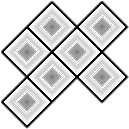
The term fracture mechanics simply refers to the forces that affect the way something breaks. In this particular case we are interested in the ways in which particular kinds of stone break. Fracture mechanics help to explain why there is a right and a wrong way to work stone in the process of tool making. It also helps to explain why certain types of stone are much better for tool making than others, and why they were thus preferentially selected by peoples in all parts of the world during all periods of time.
The two most important factors affecting the fracture mechanics of rocks are the graininess of the rock and the rock's elasticity.
For our example, lets assume that there are four basic kinds of rock structures, as shown above. These are crystals, conglomerates, homogenous large particle rock, and homogenous small particle rock. The structure of each of these four types of rock affect the way in which they will break. Lets go on to see how they break.

Crystals will shear along crystal planes.

Conglomerates tend to break irregularly and will not produce a sharp edge.

Homogenous Large Particle Fracture
A homogenous, large particle material will exhibit more regular fracturing, but will not develop very sharp edges.

Homogenous Small Particle Fracture
A homogenous, small particle material will exhibit the most regular fracturing, and will form very sharp edges.

The size of a rock's particles is often referred to as the graininess of the rock. Thus, the smaller the particles the more fine-grained the rock. Very fine grained rocks such as flint, chert, and chalcedony can produce extremely sharp edges. Obsidian, naturally formed glass from volcanic deposits, is technically a supercooled fluid and hence has no crystalline structure or grain at all. The edges produced by fracturing obsidian can literally be measured in microns!
In general, the very best materials for making stone tools are obsidian, and cryptocrystalline quartzes such as chert, jasper, etc.
The second factor affecting the fracture mechanics of rocks is their elasticity. Elasticity refers to the tendency of a material to rebound from the effects of a force applied to it. Elasticity varies along a continuum from brittle (no flexibility) to plastic (no elasticity). For example, crystalline iron pyrite (fools gold) shatters when you press a piece between a pocketknife blade and your fingernail. It has very little flexibility and hence is brittle. Pure gold, on the other hand will spread like butter under the same conditions. It is extremely flexible, but has no elasticity, so it can be molded like clay. Thus gold is plastic.
The ideal material for making stone tools is tough, but has enough flexibility to bend rather than break when force is applied to it, but has enough elasticity that it does not deform under force. Again, obsidian and the cryptocrystalline quartzes have just the right blend of flexibility and elasticity to be perfectly suited to stone tool manufacture.
The more elastic a material is, the more likely that it will tear or shear under extreme stress rather than shatter. Combine this tendency with a material composed of very small particles and you have the makings of an excellent raw material for the kind of technology applied to flintknapping.
The hallmark of a good raw material is that it will break in a cone, or section of a cone, when the right amount of force is applied in the right place. These are also called Hertzian cones after the man who first explained how they are formed. A good example of this principle is the ring fracture that occurs when a bee-bee (small lead pellet) strikes a window pane. The same principle applies when you strike a flake off of a chert core, with the exception that instead of a full ring fracture you get a conic section.
|
|
|
|